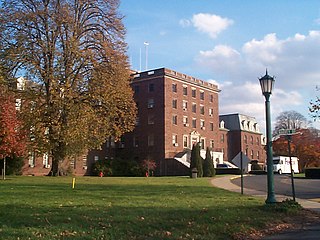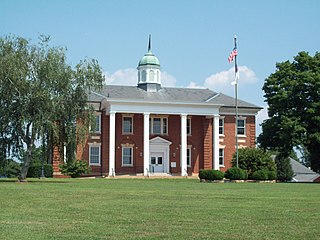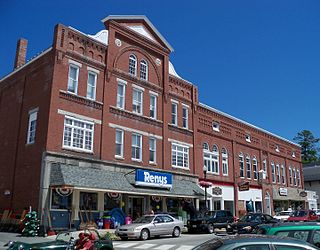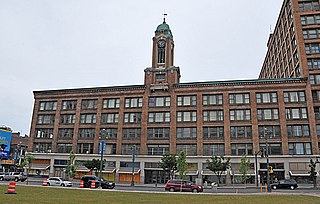
Farmington is a city in St. Francois County located about 75 miles (121 km) southwest of St. Louis in the Lead Belt region in Missouri. As of the 2020 census, the population was 18,217. It is the county seat of St. Francois County. Farmington was established in 1822 as Murphy's Settlement, named for William Murphy of Kentucky, who first visited the site in 1798. When St. Francois County was organized, the town was briefly called St. Francois Court House and later renamed to Farmington.

William Jewell College is a private liberal arts college in Liberty, Missouri, United States. It was founded in 1849 by members of the Missouri Baptist Convention and endowed with $10,000 by William Jewell. It was associated with the Missouri Baptist Convention for over 150 years until it separated in 2003 and became independent. After becoming a nonsectarian institution, the college's enrollment fell by approximately 40% to 739 students in 2018. Jewell is accredited by the Higher Learning Commission.

Marycrest College Historic District is located on a bluff overlooking the West End of Davenport, Iowa, United States. The district encompasses the campus of Marycrest College, which was a small, private collegiate institution. The school became Teikyo Marycrest University and finally Marycrest International University after affiliating with a Japanese educational consortium during the 1990s. The school closed in 2002 because of financial shortcomings. The campus has been listed on the Davenport Register of Historic Properties and on the National Register of Historic Places since 2004. At the time of its nomination, the historic district consisted of 13 resources, including six contributing buildings and five non-contributing buildings. Two of the buildings were already individually listed on the National Register.

Westminster College is a private college in Fulton, Missouri. It was established in 1851 as Fulton College. America's National Churchill Museum is a national historic site located on campus. The school enrolled 609 students in 2020.
Burlington is a census-designated place (CDP) in Mineral County, West Virginia, United States, along U.S. Route 50 crossing Pattersons Creek. As of the 2020 census, its population was 131. It is part of the Cumberland, MD-WV Metropolitan Statistical Area.

Connecticut Valley Hospital in Middletown, Connecticut, is a public hospital operated by the state of Connecticut to treat people with mental illness. It was historically known as Connecticut General Hospital for the Insane. It is a 100-acre (40 ha) historic district that was listed on the National Register of Historic Places in 1985.

Theodore C. Link, FAIA, was a German-born American architect and newspaper publisher. He designed buildings for the 1904 World's Fair, Louisiana State University, and the Mississippi State Capitol.
Thornwell opened in Clinton, South Carolina on October 1, 1875, to ten orphaned children. It was founded by Reverend William Plumer Jacobs and named for noted theologian James Henley Thornwell. Dr. Jacobs went on to found Presbyterian College and his son Thornwell Jacobs revitalized Oglethorpe University.
St. Mary’s Health System, a member of Covenant Health, was founded in 1888 by the Sisters of Charity of Saint-Hyacinthe. Today, it is an integrated medical system comprising a 233-bed acute care community hospital, an employed group of primary care and specialty providers, urgent care and emergency department, an extensive complement of behavioral and mental health services and outpatient specialty practices. The system also includes d’Youville Pavilion, a senior care community that offers a rehabilitation center, long-term skilled nursing care and memory care. Its historic Saint Mary's General Hospital building, built in 1902, is listed on the National Register of Historic Places.

Augusta Downtown Historic District is a historic district that encompasses most of Downtown Augusta, Georgia and its pre-Civil War area.

Johnston Hall is a historic building located on the campus of Elon University in Elon, Alamance County, North Carolina. It was built in 1925, and is a substantial, two-story, H-shaped, red brick Classical Revival style building. The front facade features a one-story flat-roof porch carried by brick piers. The building is the historical centerpiece of the Elon Homes for Children campus, an orphanage founded in 1907. The building is named for Charles David Johnston, superintendent of the orphanage.

The Protestant Children's Home, also known as the Protestant Orphans' Asylum, is a historic orphanage building in Mobile, Alabama, United States. It was placed on the National Register of Historic Places on June 18, 1973.
In 2015 the building was leased to the Infant Mystics society which began using it as a meeting lodge, renaming the place Cotton Hall.
The University of Arkansas Campus Historic District is a historic district that was listed on the National Register of Historic Places on September 23, 2009. The district covers the historic core of the University of Arkansas campus, including 25 buildings.

The Stephens College South Campus Historic District is a national historic district on the campus of Stephens College in Columbia, Missouri. It includes the historic core of Stephens College in Eastern Downtown Columbia, Missouri. The District includes Senior Hall, Hickman Hall, Columbia Hall, and Wood Hall.

Presbyterian Orphans Home, now known as Presbyterian Homes & Family Services, is a historic "cottage style" orphanage complex located at Lynchburg, Virginia. It consists of six residence halls, a superintendent's house, and an executive building, all constructed of brick in the Georgian Revival style. Also on the property is a Greek Revival style gymnasium. Other contributing buildings and structures include the maintenance building, swimming pool, two farmhouses, dairy barn, stable, barn, and entry gates. A contributing site is the campus circle.

The Baldwin-Wallace College South Campus Historic District is an area of land on the south end of the Baldwin Wallace University campus. When the district was established, the school was Baldwin-Wallace College. BW is a four-year private, coeducation, liberal arts college in Berea, Ohio, United States. The school was founded in 1845 as Baldwin Institute by Methodists settlers. Eventually the school merged with nearby German Wallace College in 1913 to become Baldwin-Wallace College, which adopted the present name in 2012. Several buildings since its founding have been established on the National Register of Historic Places, establishing this area as the Baldwin-Wallace College South Campus Historic District.

The Farmington Historic District encompasses much of the main central business district of Farmington, Maine. Farmington was settled in the 1770s, and experienced its most rapid growth after being named the shire town of Franklin County in 1838, with a secondary spurt of redevelopment after a major fire in the 1880s. Its central business district encompasses many of the town's historic resources, and its most significant commercial and civic architecture. The district, which includes more than 130 resource over 85 acres (34 ha), was listed on the National Register of Historic Places in 1995.

The West Liberty Commercial Historic District in West Liberty, Iowa, United States, is a historic district that was listed on the National Register of Historic Places in 2002. At that time, it included 41 contributing buildings, six other contributing structures, and eight non-contributing buildings.

Sibley's, Lindsay and Curr Building is a historic commercial building located at Rochester in Monroe County, New York. It was designed by noted Rochester architect J. Foster Warner and built for Sibley's in 1904. The original wing of the building was constructed in 1906 as a five-story, Chicago school style skeletal steel building sheathed in brown Roman brick with deeply set Chicago style windows, topped by a clock tower with Baroque and Renaissance style details. Additions were made to the building in 1911 and 1924, including a 12-story tower section.

The Morristown District, also known as the Morristown Historic District, is a historic district in the town of Morristown in Morris County, New Jersey. It was added to the National Register of Historic Places on October 30, 1973, for its significance in architecture, communications, education, military, politics, religion, social history, and transportation.




















